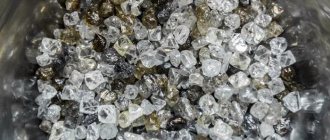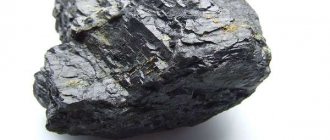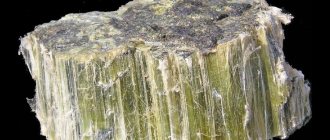Marketers came up with the iconic slogan “Diamonds are Forever” for De Beers more than a hundred years ago. Agree, this is a brilliant move: two words made diamonds in people’s minds a symbol of wealth and eternal love. And at the same time, they provided confidence for diamond mining companies in their own future.
De Beers, by the way, still maintains its reputation as a major diamond producer. However, in terms of volume and value of diamonds mined in the world, it is in second place. The leader of this very specific market is the Russian Alrosa.
This market is unusual. Judge for yourself: the main influence here is exerted by the five largest companies; in total they mine three quarters of the world's diamonds - the cost of entering the market is very high. Artel companies, of course, are difficult to count, but they certainly cannot reach the heights of the Big Five.
“The diamond market can be compared to the platinum group metals market, where just a few companies dominate. There are also similarities between diamonds and PGMs in the geographical location of the deposits - Russia and African countries are at the top. But the diamond market is relatively small - in monetary terms it is 10 times smaller than the PGM market and 100 times smaller than the gold market.
The demand for natural diamonds is not so great that a larger number of deposits could operate profitably,” explained Mikhail Dyagilev, Chairman of the Committee for Supporting Entrepreneurship in the Field of Mining, Production, Processing and Circulation of Precious Metals and Precious Stones of the RF Chamber of Commerce and Industry, General Director of Krastsvetmet OJSC.
Diamond mining
Diamonds are formed when carbon is exposed to high temperature and pressure. There are three types of deposits:
- Indigenous. The crystal lattice of graphite is reconstructed into diamond at a depth of 110–150 km. When a volcano erupts, some gems are thrown to the surface along with magma, while some remain underground. The long volcanic vent is called a kimberlite pipe (after the city of Kimberley in Africa), where such deposits were discovered.
- Impact. Formed at the site of the fall of asteroids and meteorites.
- Placer. It occurs as a result of erosion of kimberlite pipes by wind, rain, and streams from the mountains. The rock is destroyed, exposing placers of gems.
For the stone to appear, the following conditions must be met:
- several hundred years;
- pressure from 50 thousand atmospheres;
- temperature from 1200 °C.
Finding and developing a deposit requires a lot of time and financial investment. You need special equipment and a lot of workers - to extract 1 carat, up to half a ton of rock is processed.
Russia is rich in gems. They are mined in many areas.
The first diamond in Russia was found in the Perm region in 1829 by serf P. Popov, who discovered a transparent stone. Pavel received his freedom, and crystals are still being mined at the site of the find.
Mining is carried out at a depth of 500–1500 m, which requires the miner (the name of the profession of one who mines precious stones, derived from “to work in the mountain”) endurance and strict adherence to instructions.
When large deposits of a mineral are discovered, the nature of its extraction becomes industrial. Examples:
- Mir kimberlite pipe in Yakutia;
- ALROSA association in the north of the Russian Federation;
- Venice quarry in Angola.
Industrial types of diamond deposits are determined by a geological precursor - bluish kimberlite. Finding this color in the upper layers of the soil indicates a large amount of minerals.
Due to the shortage of raw materials and the high demand for diamonds, there is an urgent need to replenish raw materials.
They learned to grow gems in laboratories, simulating natural conditions.
At the same time, the growth period was reduced to a week. The first Soviet synthetic diamonds were produced in 1961. Their production continues to this day.
In addition to watching a documentary on the topic:
Technological cycle
The placers are found in sands that require a beneficiation process. In primary deposits, stones are interspersed with mountain kimberlite. The development of placer deposits presents certain difficulties:
- the need to restore large areas of soil removed during the mining process;
- removal from the raw material processing point;
- moving equipment to a new location when the previous one is depleted.
A quarry or mine has fewer disadvantages and allows for the extraction of large volumes of stones. The technological cycle for any mining method includes:
- geological exploration, calculations of approximate volumes of deposits;
- acquisition of special equipment;
- equipment of the excavation site;
- rock mining;
- delivery to the mining factory.
Often the cycle includes the construction of a processing plant - it is cheaper to cut and polish stones within one company than to transport them somewhere.
Extraction methods
There are three types of developments through which gems are mined.
Career
In this way, diamonds are mined at a depth of up to 600, less often 1000 meters. First, wells are drilled and explosives are placed in them. The resulting rock is transported to the processing plant by truck.
Mine
A tunnel is dug deep into the earth to a depth of 500–1000 meters, then infrastructure is built - a ventilation system, elevators, transport for delivering workers, trolleys for mined ore, roads for bulldozers and other equipment.
Placers
Placer diamond deposits make it possible to find crystals without digging holes and tunnels. An ancient and cheap mining method based on washing rock using large sieves.
On the topic of stone mining, watch the video:
Top diamond mining countries
In the diamond business, leading countries change each other. Changes are related to the supply of gems, the duration of production, and the quality of raw materials. In the 21st century, the global ranking of leaders in diamond mining in percentage looks like this:
- Russia – 22;
- Australia – 20;
- Botswana – 19;
- Congo – 17;
- Canada - 10.
The largest suppliers of gems:
- Russia is a country that supplies 38.3 million carats to the world market every year. The main deposits are located in Yakutia (up to 97% of production), Arkhangelsk, Murmansk regions, Karelia, and Perm Territory.
- Canada - the main deposits are located in the northwest and north of the country, the largest are Gacho Quay and Renard. 12 million carats worth $2 billion are mined annually.
- Angola is a source of transparent pink and colorless stones. The Venice, Fukauma and other mines, of which there are more than 700, produce 8.7 million carats per year worth $1.5 billion.
- Africa has been the leader in the volumes of gems provided for almost 200 years. South Africa is now on the list of leaders, supplying up to 7.4 million carats per year.
- Botswana is the leader among all African countries, producing more than 40 million carats of diamonds per year. Their income is $2 billion annually. Rare green gems are found there. The largest deposits are Orapa, Jwaneng, Letlhakan, Damtshaa.
- Australia – diamond mining has been going on for a long time, reserves are running out. Now there is a single mining site in the Argyle mine, where rare pink crystals are found.
Open the showcase
With an eye on the giant Asian markets, in September 2016, Alrosa opened its own trading platform in Vladivostok - the Eurasian Diamond Center (EDC), which includes stands for cutting enterprises, exhibition halls and offices, customs posts and Gokhran enterprises.
Eurasian Diamond Center in Vladivostok
Photo: Eurasian Diamond Center
The simplified customs and visa rules of the free port of Vladivostok facilitate the acceleration of purchase and sale transactions of rough and polished diamonds. The most expensive diamond sold in Vladivostok cost 752 thousand dollars. Last year, the company sold $72 million worth of rough and polished diamonds at the EAC, and the plan for 2022 is to sell $80 million worth of products.
Foreigners have flocked to the diamond cluster in the Far East: last fall, the Indian company KGK Diamonds launched a cutting plant in Vladivostok with a processing capacity of 15 thousand carats of diamonds per year.
Diamonds in Russia
Russia has a huge territory with diamond deposits. They differ in origin, opening time, quality and quantity of crystals.
The first kimberlite pipe discovered in the USSR, Zarnitsa, is located in Yakutia. Its development began in 1954. Currently, the resource is almost exhausted, and almost no diamonds are mined from it.
All diamond deposits in the Urals are alluvial.
The average diameter is 2.5 mm, but larger stones are found. Diamonds have been mined in the Perm region since the beginning of the 19th century. They are distinguished by high quality, transparency, crystal purity.
The production volume is no more than 0.1-0.2% of the all-Russian total, while the cost reaches 20% of all Russian diamonds. The main deposits are located in Krasnovishersky, Gornozavodsky districts, Krasnokamsk, Cherdyn, Aleksandrovsk.
The impact Popigai diamond deposit received its name from the crater of the same name in Siberia, on the territory of which it is located. The estimated volume is 50 billion carats. Development is slow due to the lack of roads and the high cost of enrichment technology.
In October 2022, a new diamond mine was launched, located in the north of Yakutia. The Verkhnemunskoe deposit is distinguished by particularly large and pure crystals. The estimated reserve is 1.8 million carats.
Small diamonds up to 0.5 mm in size are found on the Kola Peninsula. In Kandalaksha, an active search is underway for larger specimens while gold is being mined.
To watch a story about the mining of precious stones in Russia:
Aikhal
Aikhal is the territory of Yakutia. Rich deposits of diamonds were discovered in the 60s of the 20th century - up to 8.53 carats of diamonds are extracted from a ton of ore. Main developments:
- Yubileiny Quarry - depth is 320 meters, gems have been mined since 1986. Estimated reserves are 153.2 million carats. The largest diamond deposit.
- Komsomolsky quarry - mining has been carried out since 2002, reserves are estimated at 4.8 million carats. The diamonds found are 1.5–2 times larger than the others.
- Aikhal mine - depth 305 meters, crystals have been mined since 1961. Since recently, work has been carried out using the lifting method by excavating blocks of rock.
Active work is underway to discover diamond deposits; by 2025, it is planned to launch 9 new diamond deposits in the Arctic regions of Yakutia - Bulunsky and Anabarsky. The development will be carried out by ALROSA.
Udachnaya kimberlite pipe
A rich diamond deposit, estimated at 120 million carats, is located in Yakutia. Gems have been mined there since 1955. The open-pit method was completed in 2015 at a depth of 640 meters, and underground mining continues.
View this post on Instagram
Posted by Tigran Avanian (@j26tigam) May 18, 2019 at 2:01 PDT
Kimberlite pipe Mir
The deposit was discovered in 1955 thanks to a fox. She dug a hole and scattered bluish lumps - a mixture of earth and kimberlite. Geologists sent an encrypted message: “We smoked the pipe of peace, the tobacco is excellent!”, the pipe was quickly given the name Mir.
Now it is the largest quarry in the world - its diameter is 1.5 km, depth 525 m. Due to rising air currents, planes do not fly over it. The quarry has been completed and diamonds are being extracted from a nearby mine.
View this post on Instagram
Posted by NIkolay Gavrilov (@kolitch) Oct 16, 2022 at 3:40 PDT
Deposit named after V. Grib
The second name is Verkhotinskoe. It is located in the Arkhangelsk region, 30 km from the Lomonosov deposit. The depth of the quarry is 460 m. The estimated resource is up to 100 million carats.
Deposit named after M. Lomonosov
Located in the Arkhangelsk region near the village of Pomorie, it has been operating for 40 years. The depth of the quarry is about 200 m, the width is 1.2 km. Includes 6 kimberlite pipes. Approximate reserves are 166.7 million carats. 2.6 million carats are mined annually. It is distinguished by high-quality stones in the shape of a rhombic dodecahedron.
Botuobinskaya
One of the recently developed deposits in Yakutia, gems have been mined since 2012. The deposits are estimated at 71 million carats.
Yakutalmaz
In 1957, in order to successfully develop mining operations for the extraction of rough diamonds, on the territory of the tent village “Mirny”, the Yakutalmaz trust was created. The organizers were faced with the most difficult conditions in the taiga, frosts down to -60 degrees, and the need to work in permafrost conditions in the absence of infrastructure.
- 1961 – the Aikhal pipe was opened;
- 1969 – work began on the International tube.
An underground nuclear explosion was used to open about 15 pipes between 1970 and 1980. In Mirny, during the same period, geologists opened the world’s only museum of kimberlites, where private collections of researchers were initially provided.
Diamond deposits in the world
Stones have been found all over the planet, from ancient times to the present day. Known over a thousand years ago, diamond deposits in Indonesia came into the spotlight a couple of years ago. Main points - Banjarbaru, o. Kalimantan. Locals mine diamonds in a primitive way, pumping water through the soil and filtering everything that washes out through a cloth.
Argyll, Australia
The place where the rarest pink and red diamonds are mined. Their volume is 90% of the world market. The first gems were found in 1979, and active development has been underway since then. According to the forecast, the mine will be depleted by 2022.
View this post on Instagram
Posted by Holloway Diamonds Australia (@hollowaydiamonds) Jun 18, 2022 at 4:58 am PDT
Catoca, Angola
The Catoca mine is the 4th largest kimberlite deposit in the world. 80% of all diamonds in Angola are mined by a company of the same name. The volume of gems sold in 2022 was about 8.4 million carats, and the profit was more than $1 billion.
Kimberley, South Africa
Kimberley is the diamond capital of the country. It is famous for its rare and large diamonds (Tiffany, De Beers). The stones have been mined from the 18th century to the present day; in recent years, there has been a decrease in the export of gems.
Jwaneng, Botswana
Located in the Kalahari Desert. The name translated from the local dialect means “where the pebbles are.” On the territory of the quarry, diamonds are mined by open-pit mining from 4 pipes at once. The volume of reserves is estimated at 150 million carats.
View this post on Instagram
Posted by Blessing Kgosi e tsile Kgasa (@nkgosi) Jul 10, 2018 at 4:49 PDT
Orapa, Botswana
The largest mine in the world by area, it has been operating on 2 kimberlite pipes since 1971. 11 million carats are mined annually.
View this post on Instagram
Posted by ⚒Mining Engineering Education⚒ (@miningengineeringeducation) Jul 21, 2022 at 9:12 am PDT
Minas Gerais, Brazil
The deposits have been known since the 18th century and are located on a plateau at an altitude of 1.2–1.5 km above sea level or in river valleys. Rich in large stones. About 1 million carats are mined annually.
View this post on Instagram
Posted by Áurea (@aureacamamelo) Jun 18, 2022 at 7:38 am PDT
Panna Mines, India
The deposits in the Panna province form a diamond belt 80 km long and 20 km wide. The main pipes are Hinota and Majgawan. The predicted volume is 37 million carats.
In 2022, by decision of the Supreme Court, activities in the quarries were stopped due to major environmental violations.
Unable to sell
Until 2022, the diamond industry was one of the most problematic in the world in terms of organizing a sales network. Diamonds can easily be compared to other typical exchange products - oil, gas, gold, and so on. All these goods are sold on centralized trading platforms - exchanges. The development of competition and the geographical diversity of the market has led to the fact that for most traditional goods exchanges have been working for decades; with diamonds it is a completely different story. The monopoly position of De Beers in the market until the end of the 80s of the 20th century did not allow the creation of institutional trading in diamonds: all contracts were concluded directly with the mining company, and De Beers itself dictated terms that were favorable to it. A similar scheme worked until 2022 - the largest diamond mining companies worked directly with intermediaries.
Photo: Arko Datta / Reuters
In 2022, India, the largest diamond processing hub on the planet, launched the world's first diamond futures trading on the Indian Commodity Exchange (ICEX). Initially, the trading platform launched trading in futures for diamonds weighing 1 carat, with plans for 0.3 and 0.5 carats. The exchange is still too young, so market leaders still sell most of their diamonds the old-fashioned way - by entering into medium- and long-term contracts directly.











